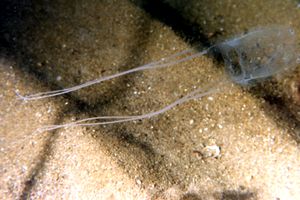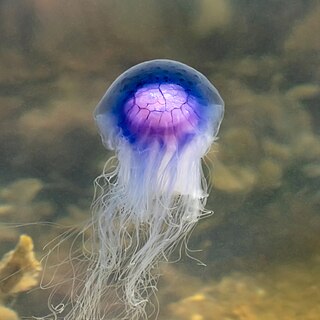
Box jellyfish are cnidarian invertebrates distinguished by their box-like body. Some species of box jellyfish produce potent venom delivered by contact with their tentacles. Stings from some species, including Chironex fleckeri, Carukia barnesi, Malo kingi, and a few others, are extremely painful and often fatal to humans.

The Irukandji jellyfish are any of several similar, extremely venomous species of rare jellyfish. With a very small adult size of about a cubic centimetre, they are both the smallest and one of the most venomous jellyfish in the world. They inhabit the northern marine waters of Australia, and cost the Australian government $AUD 3 billion annually through tourism losses and medical costs associated with stings. This type of jellyfish reproduces sexually with eggs and sperm. They fire their stingers into their victim, causing a condition known in humans as Irukandji syndrome, which can be fatal and difficult to immediately recognise due to the delayed effects of the venom. There are about 16 known species of Irukandji, of which Carukia barnesi, Malo kingi, Malo maxima, Malo filipina and Malo bella are the best known.

Carybdea is a genus of venomous box jellyfish within the family Carybdeidae that currently consists of a total of 8 species. This genus of jellyfish are often found in warm waters around the world in waters such as the Mediterranean Sea, the Pacific Ocean, and off the coast of Africa. Their sting can cause a range of effects depending on the species. These invertebrates will go through both sexual and asexual reproduction as they transform from a polyp to medusa. Carybdea have a box-shaped bell with four tentacles and eye-like sensory structures. There are distinct physical markings that differentiate many species within the genus. While Carybdea use their venom to act as predators, they are also preyed on by turtles and various fish. They feed on plankton, invertebrates, fish, and some crustaceans.

Alatina alata(Reynaud, 1830), often called a sea wasp, is a species of box jellyfish found in the Pacific, Indian and Atlantic Oceans and in the Caribbean and Arabian Sea.

Scapanus is a genus of moles in the family Talpidae. They live in North America from west of the Rockies south to Baja California del Norte, and north to British Columbia, wherever conditions permit a mole population; that is to say, apart from the most sandy, rocky, or developed places. As they are one genus, they are very closely related, but as species, they rarely if ever interbreed successfully.

Malo is one of a genus of box jellies in the family Carybdeida in the Phylum Cnidaria. It has four known species, three of which were described by the Australian marine biologist Lisa-Ann Gershwin. The genus was discovered in 2005. Many of the species are known for their paralytic and deadly affect. Many species in the Malo genus are very small and hard to capture and study. Many species of Malo have been captured on the Western and Eastern cost of Australia. Malo appear to be solidarity jellies.

Cyanea lamarckii, also known as the blue jellyfish or bluefire jellyfish, is a species of jellyfish in the family Cyaneidae.

Alatinidae is a family of box jellyfish within class Cubozoa, containing the following genera and species:

Carukiidae is a family of box jellyfish within the Cubozoa class. Carukiidae can be easily classified by their lack of cirri clumps inside the cubozoan stomach, as well as the size and the placement of their nematocysts.

Carybdea murrayana, the South African box jellyfish, is a venomous species of cnidarian, in the small family Carybdeidae within the class Cubozoa.

Alatina is a genus of box jellyfish within class Cubozoa. It is the largest of the three known genera in the family Alatinidae, and the only one which is not monotypic. It contains the following ten species:
John Handyside (Jack) Barnes MBE (1922–1985) was a physician and toxinologist in Queensland, Australia. Born in Charleville he is known for his research on the box jellyfish.
Chiropsella bronzie is a species of box jellyfish. It is considered much less of a threat to humans than some of its relatives. The species was described in 2006, and is one of four species in the genus Chiropsella. Chiropsella bronzie can be found in shallow waters off the coast of Queensland, Australia.

Tamoya haplonema is a species of box jellyfish in the genus Tamoya. It is the type species of the genus and was described in 1859. The medusa possesses four tentacles, one each on an inter-radial pedal.

Tripedalia is a genus within the family Tripedaliidae that is part of the box jellyfish, also known as the Cubozoa. There are only three known species within Tripedalia: T. cystophora, T. binata and T. maipoensis.

Carybdea brevipedalia is a venomous species of cnidarian, in the small family Carybdeidae within the class Cubozoa. The species is largely concentrated off the coast of Japan, but has also been observed in the waters near Korea.
Carybdea arborifera is a venomous species of cnidarian, in the small family Carybdeidae within the class Cubozoa. The species is rarely seen, but has been observed off the coast of Hawaii.

Carybdea rastonii is a venomous species of cnidarian, in the small family Carybdeidae within the class Cubozoa. They are usually observed near Hawaii and Australia, but have in rare cases been documented off the coasts of California.
Carybdea wayamba is a venomous species of cnidarian, in the small family Carybdeidae within the class Cubozoa. The species is rarely seen, but has been observed off the coast of Sri Lanka.
Carybdea confusa is a venomous species of cnidarian, in the small family Carybdeidae within the class Cubozoa. The species can be found in kelp forests off the coast of California.















